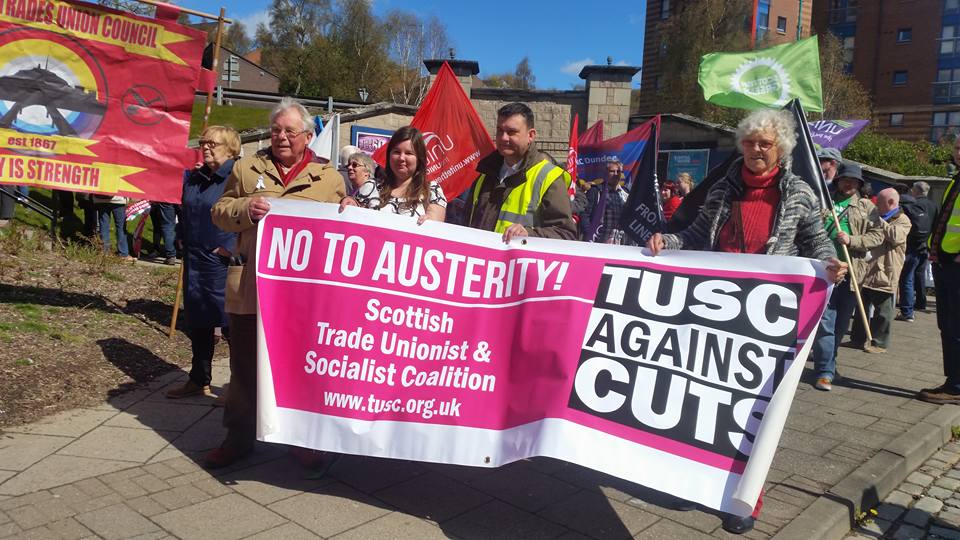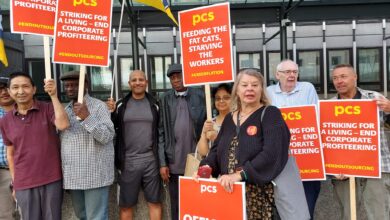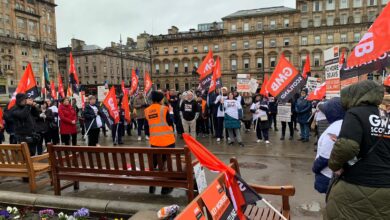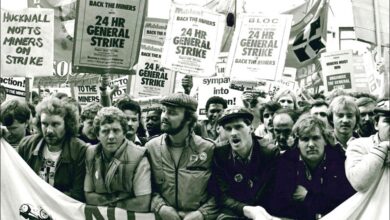Scottish march for jobs and public services inspires thousands
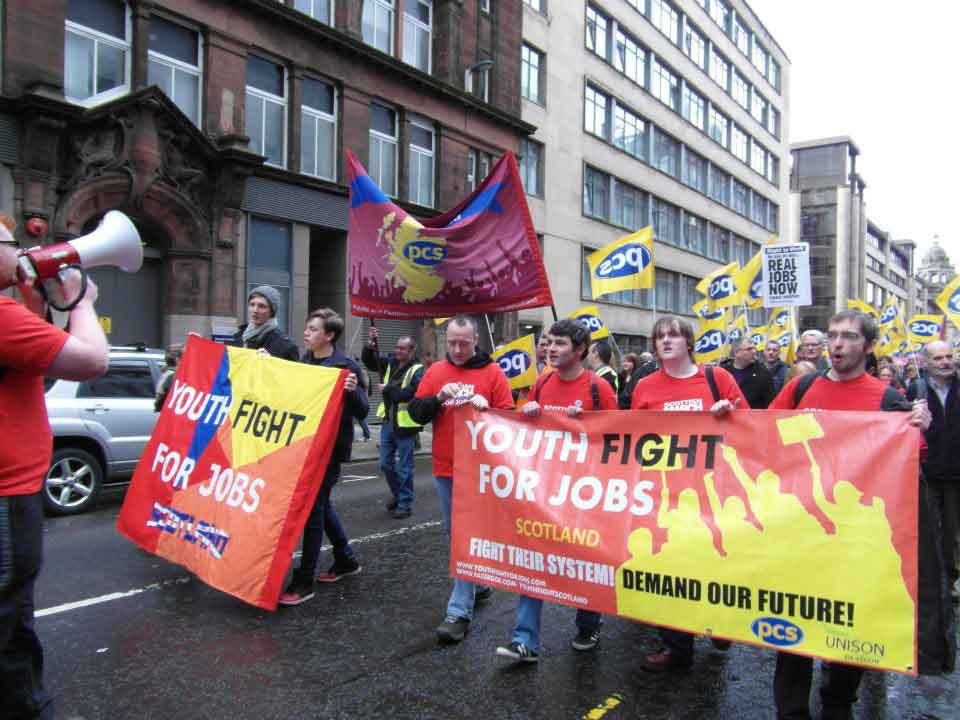
From 17th – 20th October, young people marched through the cold and rain from Stirling to Glasgow, demanding real job creation, an end to attacks on benefits, pensions and wages, free education, public works and affordable housing. The marchers reflected the position of young people in Scottish society, with long term unemployed youth joining debt ridden university and college students, exploited low paid workers and school students worried about their future, as well as PCS young members who are new workplace rep’s.
Inspired by the 2011 Jarrow March and the recent Belfast March for a Future, organised by Youth Fight for Jobs in Northern Ireland, (which a Scottish marcher spoke at) the Scottish March for Jobs and Public Services was co-organised by Youth Fight for Jobs Scotland and the PCS Young Members Network.
It was supported by PCS Scotland nationally, and the campaign funds of over twenty local PCS branches across Scotland. Glasgow City Unison, Unison Scottish Children’s Reporters and Edinburgh RMT also backed the march as did the Dundee Youth Council. The Scottish Trade Union Congress (STUC) also publicly urged support from it’s affiliates.
The march gave voice to the mass anger rising against unending austerity from the Con Dem government in Westminster, passed on by the SNP Scottish government, and Labour councils across Scotland. Through the march, Scotland’s youth and the wider working class, suffering mass unemployment and cuts, were given a fighting strategy and solutions to the crisis of capitalism. In the mass media. The marchers raised the need for young people and the organised working class through the trade union movement to come together to confront austerity, and for the trade unions to show a lead by coordinating their power into a 24 hour general strike.
For four days, Scotland’s second biggest selling newspaper, the Daily Record, ran features, photographs and interviews with marchers. The Daily Record used the march as the main reference point for it’s mobilisation campaign for the STUC demonstration. Marchers were able to put forward demands, for a mass program of job creation and public works, a critique of austerity capitalism and support for struggles of workers in Europe, such as the Spanish miners march to Madrid, to a readership of over 400,000. Marchers were also interviewed on two of BBC Scotland’s most popular show’s, Good Morning Scotland and Call Kaye Adams. The Good Morning Scotland interview took place on the first day of the march, coinciding with unemployment figures, showing a higher increase in joblessness in Scotland than the rest of Britain.
We were able to counter arguments that Scottish young people were lazy and called live on air for co-ordinated general strike action by the trade unions. We debated with business representatives and Labour MP Willie Bain on Call Kaye, raising opposition to Glasgow City Councils cuts program and calling for real skilled apprenticiships instead of workfare. The march was also featured on television news on the BBC and STV. The forty mile route, over three days, took us from Stirling to Larbert, Milngarvie and through North West Glasgow into the city centre.
Marchers braved appalling weather conditions to tell all they saw to come onto the streets on Glasgow with the trade unions on Saturday and to get organised against austerity. Workers beeped horns along the road or stopped driving to donate to the march and we were applauded by shoppers in Glasgow and joined spontaneously by local youth for the last mile.
The route showed us the devastation wrecked on working class communities by decades of austerity, from the pit villages on the outskirts of Stirling that Thatcherism has made ghostly to the town of Kirkintilloch, built as part of the mass council housing program by the Labour government that now suffers high levels of drug addiction and unemployment. We were met by PCS members showing solidarity at the DWP offices in Glasgow Northgate on the last leg of the march.
The STUC and PCS organised a reception for marchers when they reached Glasgow. Speakers at the reception included John McInally National Vice President of the PCS and Dave Moxham Deputy General Secretary of the STUC. Dave Moxham, highlighting the mass media coverage the march had received had “captured the heart and imagination of the trade union movement and had played a role in convincing thousands to march on October 20th”.
The marchers, in red t-shirts chanting “public sector, private sector, unite and fight, let’s build a general strike” proudly led the PCS contingent on October 20th. (see picture) PCS Scottish Secretary Lynn Henderson got one of the loudest cheers of the STUC rally in Glasgow Green, when she called for appaulse for the “brave young people and trade unionists who have marched from Stirling”. The march has lifted the profile of Youth Fight for Jobs and the PCS Young Members Network onto a national level and has given concrete demands to enraged politicised young people.
School Student marcher David Mundt “”I felt that the march was a great success and received tremendous support from the public – which highlights the discontent with the cuts. Even though it was hard going and at times it would’ve have been easy to give up, I kept going because our cause is just. We need to build on the success of the march and sustain a strong campaign to fight austerity.” Youth Fight for Jobs is going to do exactly that we are discussing organising further marchers, strengthening links with the trade unions and launching a specific campaign around apprenticiships and job creation.
